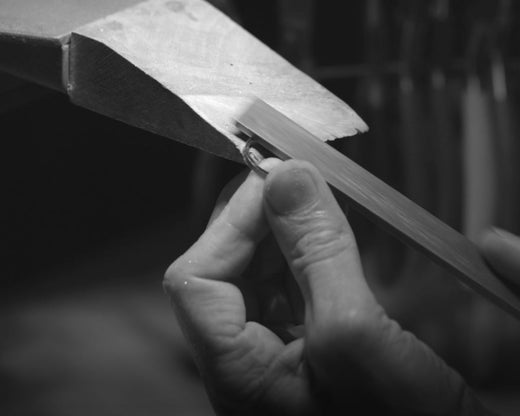For decades, the solitaire setting has been one of the most popular styles of engagement ring. But how do you know if it is the right choice for you?
Well, we tell you all about the iconic style in our latest blog. Read on to learn more about the solitaire setting, including what it is, what type of stones can be set in this way, and how to care for a solitaire style, all in the hopes that we can help you on your way to finding your dream engagement ring.

What is a solitaire engagement ring?
A solitaire engagement ring refers to the way in which a precious stone has been set on a ring. The solitaire style describes a single stone mounted onto a ring. Traditionally, the stone sits alone, in a yellow, white or rose gold setting, and is held in place by small claws, or prongs.
The single, central precious stone creates a powerful impact when worn, which is why it is such an admired style. It is simple, yet bold, timeless, yet stylish - ultimately, the perfect choice for so many brides-to-be.
Different types of solitaire engagement rings
Although the solitaire style is simple in design, there is almost an endless amount of possibilities when it comes to the types of solitaire rings available. Both diamonds and other precious gemstones can be set in a solitaire style. The choice is simply up to each individual’s personal preference. For instance, if you are someone with a classic style, then a traditional white diamond might be the most appealing option. For those who prefer a pop of colour, try a ruby, emerald or sapphire in just about any shade at the centre of your ring.
The stone you choose can also be cut in a multitude of ways. Therefore, solitaire engagement rings are available with everything from round brilliant, oval and emerald cut stones, to cushion, princess, marquise and more.
Each cut is unique, bringing its own individual characteristics to the overall ring design. For instance, a round brilliant cut is a classic choice, while a princess cut stone is more contemporary. Similarly, the elongated shape of marquise and oval cuts flatter any hand they grace by making the finger appear longer and slimmer.
Solitaire engagement rings look beautiful in every metal type, too. Again, the metal you choose is completely down to preference, with options available in traditional yellow gold, bright white gold or stylish rose gold, as well as the modern day favourite, platinum.
When did solitaire rings become so popular?
The history of the solitaire ring spans centuries. When engagement rings first began to be gifted, women would be given two - one made of gold which could be worn outside, and another made of iron for wearing around the house. These early rings were simply plain bands of metal.
That was until the 15th century, when the first diamond ring was commissioned by Archduke Maximilian of Austria to present to his soon to be wife, Mary of Burgundy. However, the trend of choosing diamonds to sit at the heart of an engagement ring didn’t quite pick up until the 19th century. By now, diamond mining was common and the sparkly stones were becoming increasingly popular.
The simplicity of the solitaire style meant it was one of the first to really pique people’s interest. These rings provided the perfect balance of tradition and trend, which continues into this very day.
Now, thanks to the variety of collections in terms of cut, carats, colours and clarities, there are endless ways to make the classic style your own, without having to sacrifice all the historical significance and meaning of the precious piece of jewellery.
Caring for a solitaire engagement ring
A solitaire engagement ring will likely be a significant investment for you and your partner. Not only will it hold a large amount of sentimental value, but it will require financial commitment too. Therefore, knowing how to care for this style of ring is essential before making your purchase, as this will help you determine whether it is the right choice for you. You want to choose a ring that suits your lifestyle and activities. There are plenty of options suited tor all different types of people, but here’s what you should keep in mind for a solitaire ring.
Solitaire engagement rings require a special level of care and commitment. Although you can be certain that an expertly crafted ring is safe and secure, the exposed nature of a diamond or precious gemstone in a solitaire setting does leave it susceptible to damage. If not worn with care, knocks and contacts can scratch, or worse, chip the daimond or gemstone.
Therefore, it is essential that a solitaire ring is taken off and safely stored before any hands on tasks. This can become a nuisance to someone with a labour intensive job for instance, which is why it is important to do your research on the types of rings available before making your decision.
Similarly, claws or prongs can snag and become loose over time. If this goes unnoticed it could cause diamonds to loosen or fall out. In order to prevent both of these issues it is vital to have your solitaire ring serviced and cleaned by an expert jeweller every six months. During your appointment, we will give your ring a deep clean, polishing away any scratches to the metal to keep it looking brand new, as well as closely examine the stone and its setting in order to prevent any potential issues.
Ultimately, a solitaire engagement ring requires commitment, while also being one of the most powerful symbols of yours to your partner. Like any significant purchase, it requires a lot of thought and research, which we are on hand to help you with. Simply, get in touch and we’ll help you on your way to finding your dream ring.





